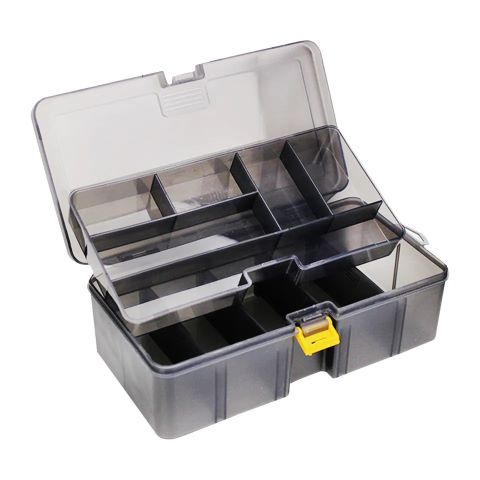
Tackle boxes are indispensable companions for UK anglers venturing into the abundant waters of the surrounding seas and coastal areas.
These specialised containers are designed to store, organise, and protect an angler’s arsenal of fishing gear, ensuring they have everything they need for a successful and enjoyable fishing expedition.
Whether targeting species like cod, bass, mackerel, or haddock, having well-equipped tackle storage is vital for British anglers to optimise their chances of landing that prized catch.
In the United Kingdom, where angling is a popular recreational activity and a thriving sport, anglers rely on tackle boxes to keep their gear in order and readily accessible.
They come in various forms, from compact bags to multi-tiered systems, each tailored to meet the specific needs and preferences of individual anglers.
With durable construction, intelligent design features, and ample storage capacity, they are essential tools that enable anglers to navigate the challenges of the UK’s diverse marine environments.
This article will explore the different types of tackle boxes commonly used by UK anglers, highlighting their key features and benefits.
From bags and boxes to seat boxes and rucksack systems, we will delve into the variety of options available, shedding light on how they enhance an angler’s experience and ensure they are well-prepared to face the ever-changing conditions of the UK’s coastal waters.
Whether you are a seasoned sea angler or a beginner venturing into the captivating world of fishing, understanding the significance of a well-organised tackle box is crucial.
Join us as we delve into their features and characteristics, uncovering their importance and functionality in the context of the UK’s vibrant angling scene.
In the UK, there are several types of sea fishing gear storage commonly used by anglers.
These include:
- Tackle Boxes: They are designed specifically for sea angling are available in various sizes and materials. Generally they are made of sturdy plastic or metal and feature multiple trays or compartments that can be customised with dividers. They provide excellent protection for gear and are suitable for anglers who prefer a more organised storage solution.
- Seat Boxes: Seat boxes are larger, more robust storage solutions that serve a dual purpose as a seat. They often have a cushioned lid, which provides a comfortable place to sit while angling. Seat boxes have ample space for storing larger items like reels, rigs, and bait boxes. They usually come with multiple drawers or compartments for organising gear.
- Tackle Bags: These are popular among sea anglers due to their portability and versatility. They are usually made of durable fabric or nylon and feature multiple compartments and pockets for storing gear. Some of them have a shoulder strap or carry handles for easy transportation.
- Rucksack Tackle Systems: These are backpack-style storage solutions designed for sea fishing. They combine the convenience of a backpack with the functionality of tackle storage. Rucksack systems feature multiple compartments, pockets, and attachment points for securing tackle. They are ideal for anglers who need to carry their gear over longer distances or when fishing from more remote locations.
- Bait Buckets and Containers: While not technically tackle boxes, bait buckets and containers are essential equipment. These are specially designed containers used to store live bait, such as worms, sand eels, or squid. Bait buckets typically have a secure lid to prevent the bait from escaping and are made of materials that can withstand exposure to seawater.
Storage Solutions Pros and Cons
| Storage Solution | Pros | Cons |
|---|---|---|
| Tackle Boxes | They come in various sizes and materials. Sturdy construction for gear protection. Customisable with dividers. Offers organised storage. | May be heavy and less portable. |
| Seat Boxes | Dual purpose as a seat. Cushioned lid for comfort. Ample space for larger items. Multiple compartments for organisation. | Bulkier and less portable than other options. |
| Tackle Bags | Portable and versatile. Multiple compartments and pockets. Some have shoulder straps for easy transport. | May not provide as much gear protection. |
| Rucksack Tackle Systems | Backpack-style with multiple compartments. Combines convenience and functionality. Ideal for longer distances or remote locations. | May not offer as much gear protection. |
| Bait Buckets/Containers | Essential for live bait storage. Secure lids prevent bait escape. Designed to withstand exposure to seawater. | Not suitable for storing other tackle. |
It’s worth noting that the type of storage that someone chooses depends on personal preference, the amount and type of gear they use, as well as the specific fishing conditions they encounter.
Fishing Tackle Boxes
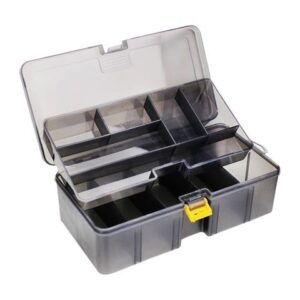
Tackle boxes are essential tools that help anglers store and organise their gear specifically for saltwater environments.
Design and Materials
- Boxes designed for sea fishing are typically constructed with durable and corrosion-resistant materials to withstand the harsh conditions of saltwater environments. Common materials include sturdy plastic, corrosion-resistant metals like aluminium, or heavy-duty fabric.
- The boxes are often designed to be waterproof or have water-resistant features to protect the gear from saltwater exposure and prevent rust or damage.
- Some have reinforced hinges, latches, or seals to provide additional protection against water intrusion.
Storage Compartments
- They feature multiple compartments, trays, and drawers that allow anglers to organise their gear and accessories efficiently.
- The compartments are designed to accommodate a variety of gear such as hooks, sinkers, lures, lines, swivels, bobbers, leaders, and other essential tools needed for saltwater fishing.
- Many tackle boxes have adjustable dividers or modular storage systems that allow anglers to customise the interior space according to their specific needs.
- Transparent lids or doors are common in boxes, allowing anglers to easily identify the contents of each compartment without opening the box.
Specialised Features
- They may incorporate additional features to cater to the specific needs of saltwater anglers. For example, some models include built-in rod holders or attachment points to secure rods during transportation.
- Certain boxes have specialised compartments or trays designed to hold items like bait, fillet knives, pliers, or other tools commonly used in sea fishing.
- Some advanced options may include LED lights to provide visibility in low-light conditions or insulated compartments to keep bait or beverages cool during fishing trips.
Portability and Carrying Options
- Boxes are designed to be portable and offer convenient carrying options for anglers. They often come with handles, shoulder straps, or even backpack-style straps for easy transportation.
- Some of them have wheels or trolley-like designs, making it more manageable to move them over longer distances or rough terrains, especially when fishing from piers, jetties, or boats.
Protection and Durability
- They prioritise protecting the gear from saltwater exposure, impacts, and rough handling and are constructed with sturdy materials to withstand the demands of the marine environment.
- The boxes are designed to keep your gear secure and prevent items from shifting or becoming damaged during transportation or while fishing in rough conditions.
Tackle boxes play a crucial role in keeping tackle organised, protected, and easily accessible in saltwater environments. With their specialised features and durable construction, they offer anglers the convenience and functionality needed to have successful angling experiences.
Fishing Seat Tackle Boxes
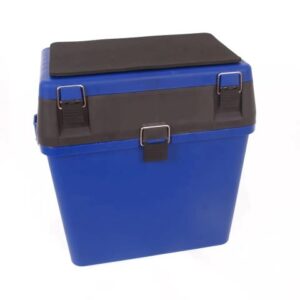
Seat boxes are popular among sea anglers, particularly those who spend long hours fishing from the shoreline or piers. These boxes serve a dual purpose as a storage solution for gear and as a comfortable seat during fishing sessions.
Below is more information about seat boxes:
Design and Features
- Seat boxes are typically made of robust, waterproof materials like plastic or heavy-duty fabric to withstand exposure to saltwater and harsh weather conditions.
- They are designed to provide a stable and comfortable seating option for anglers, often featuring a cushioned lid or seat pad.
- Seat boxes usually have a hinged lid that opens to reveal the storage compartments within. The lid can be secured in place to prevent accidental closure while accessing gear.
- The interior of a seat box consists of various compartments, drawers, and trays for organising gear. These compartments are often adjustable or removable, allowing anglers to customise the storage space according to their needs.
- Some seat boxes may have additional features like built-in rod holders or attachment points for securing additional accessories like rod rests or keep nets.
Storage Capacity
- Seat boxes are known for their generous storage capacity, allowing anglers to carry a wide range of gear and equipment. They can accommodate items like reels, terminal tackle boxes, spare fishing lines, bait boxes, tools, and other essentials.
- The storage compartments in a seat box are designed to keep gear organised and easily accessible, saving anglers time when searching for specific items during angling sessions.
Portability
- While seat boxes offer ample storage space, they are also designed to be portable. They often feature handles or carry straps for easy transportation from one fishing spot to another.
- Some seat boxes may have additional wheels or a trolley-like design, making it even easier to transport them over longer distances or rough terrain.
Versatility
- Seat boxes are not limited to shore or pier fishing. They can also be used for the boat, providing anglers with a comfortable seating option and convenient storage for their gear.
- The sturdy construction of seat boxes makes them suitable for handling the demands of sea fishing, where tackle may be exposed to saltwater, rough handling, and harsh weather conditions.
Overall, seat boxes are a popular choice among sea anglers who prioritise comfort and convenience while having ample storage space for their gear. These versatile boxes allow anglers to stay organised, have easy access to their gear, and provide a comfortable seating option during long sessions.
Fishing Tackle Bags
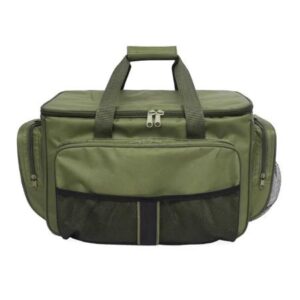
These are a popular choice among sea anglers who prefer a portable and versatile storage solution for their gear.
Below is some more information about tackle bags:
Design and Features
- They are typically constructed from durable and water-resistant fabrics such as nylon or polyester. This ensures they can withstand exposure to saltwater and provide protection for the gear inside.
- They are designed to be lightweight and easy to carry, often featuring adjustable shoulder straps or carry handles. Some models may even have padded straps or additional waist straps for added comfort during longer trips.
- Many of them have have multiple compartments, pockets, and sleeves, providing anglers with ample storage options. These compartments are designed to accommodate various sizes of boxes, reels, tools, and other accessories.
- Some of them may have transparent or mesh pockets, allowing anglers to easily see the contents and quickly locate specific items without having to open each compartment.
- The main compartment of a tackle bag is usually spacious enough to hold larger items like bait containers, spare clothing, or a small tackle box.
Storage Capacity and Organisation
- Bags come in different sizes, offering varying storage capacities to suit different anglers’ needs. Smaller versions may be suitable for anglers who carry a minimal amount of gear, while larger ones can accommodate a more extensive range of gear.
- The compartments often feature adjustable dividers or removable trays, allowing anglers to customise the internal storage space according to their preferences and gear requirements.
- Some may have specialised pockets or sleeves for holding items like pliers, hooks, lines, or even a small rod.
- The organisation within a tackle bag is crucial for efficient fishing. Anglers can categorise their gear and accessories into different compartments, making it easier to find and access specific items during angling sessions.
Additional Features
- Some of them may have additional features like D-rings, attachment points, or loops for securing external accessories such as rod holders, landing nets, or tools.
- Some may incorporate insulated compartments or pockets specifically designed to keep bait or drinks cool during hot weather.
- Certain models may include waterproof or weather-resistant zippers and closures to protect the tackle from water intrusion or splashes.
Versatility
- They are versatile and suitable for various scenarios, including shore, pier, or even the boat. They are easy to carry and allow anglers to move freely while keeping their gear organised and accessible.
- They are also convenient for anglers who prefer to switch locations frequently or explore different spots. They can be easily transported and provide all-in-one storage for essential gear.
Overall, tackle bags provide sea anglers with a portable, organised, and versatile storage solution for their gear and accessories. They offer convenience and easy access to gear, making them a popular choice for anglers who value mobility and efficiency during their fishing trips.
Fishing Rucksack Tackle Systems
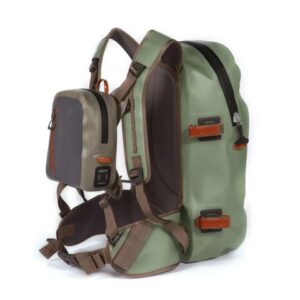
Rucksacks and backpacks are highly convenient and practical storage solutions for anglers who prefer a backpack-style approach to carrying their gear.
Following is some more information about rucksack tackle systems:
Design and Features
- Rucksacks systems are designed in the form of backpacks, combining the functionality of a tackle box with the portability and comfort of a backpack.
- They are typically constructed using durable and water-resistant materials to withstand the challenges of sea fishing, such as exposure to saltwater and rough handling.
- They have a main compartment that serves as the primary storage area for larger gear items like reels, bait boxes, clothing, and other essentials.
- Additional compartments, pockets, and attachment points are strategically placed throughout the backpack to accommodate smaller items, such as terminal tackle boxes, tools, and accessories.
- Some rucksack systems may have external pockets or mesh compartments specifically designed to hold water bottles, keeping anglers hydrated during fishing trips.
Storage Capacity
- Rucksacks offer ample storage capacity to accommodate a wide range of gear and equipment.
- The main compartment of the backpack is spacious and can hold larger items, while the various additional compartments and pockets allow for organisation and easy access to smaller items.
- These systems often provide adjustable dividers or compartments, enabling anglers to customise the interior space according to their specific needs and preferences.
Portability
- Rucksack systems are designed for easy transportation and convenience. They feature padded and adjustable shoulder straps to ensure comfortable carrying, even over longer distances or rough terrain.
- Some rucksack systems may also include a chest strap or waist belt to distribute the weight more evenly and provide additional stability during movement.
- The backpack design allows anglers to have their hands free, making it easier to navigate uneven surfaces or carry additional equipment.
Versatility
- Rucksacks are versatile and suitable for various environments, including shore, pier and boat fishing.
- They are particularly useful when anglers need to move around frequently or access more remote spots where a traditional tackle box may be less practical.
- Rucksack systems often feature durable construction and materials, making them suitable for withstanding the rigors of sea fishing.
They offer anglers a convenient and portable storage solution for tackle. With their backpack design and ample storage capacity, these systems allow anglers to carry their gear comfortably, keep everything organised, and easily access their gear while enjoying their fishing adventures.
Fishing Bait Buckets and Containers
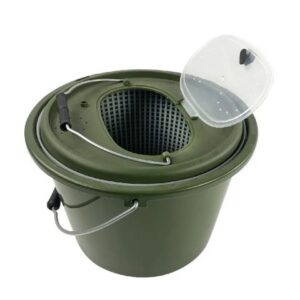
Bait buckets and containers are essential tools anglers, specifically for storing and transporting live bait. They play a crucial role in keeping bait fresh and readily accessible during fishing trips.
Below is some more information about bait buckets and containers:
Design and Features
- Bait buckets and containers are typically made of durable materials such as plastic or heavy-duty, corrosion-resistant metals. This ensures they can withstand exposure to seawater and the elements.
- They come in various sizes, ranging from small containers to larger buckets, depending on the amount of bait you need to carry.
- Bait buckets usually have a secure lid or cover to prevent the bait from escaping, while still allowing air circulation to keep the bait alive and healthy.
- Some bait containers may have built-in aeration systems or holes in the lid to ensure proper oxygenation for the live bait.
- Bait buckets often feature a sturdy handle or carrying strap for easy transportation to and from the fishing location.
Types of Bait Containers
- Standard Bait Buckets: These are basic, no-frills containers with a lid, designed to keep bait contained and prevent spillage. They are commonly used for carrying live baits like worms, sand eels, shrimp, or small fish.
- Insulated Bait Buckets: Insulated bait buckets or containers are designed to regulate temperature and keep the bait cool. They have additional insulation layers to prevent temperature fluctuations, which is particularly useful when carrying delicate baits that require a specific temperature range.
- Floating Bait Buckets: Floating bait buckets are designed to float in the water, allowing anglers to keep the bait at the desired depth or float it alongside a boat or pier. These containers often have a buoyant construction and a secure lid to prevent water from entering.
Benefits and Usage
- Bait buckets and containers are crucial for keeping live bait in optimal condition, as fresh and lively bait is more enticing to target fish species.
- They help preserve the bait’s natural scent and movement, which are key factors in attracting fish.
- Bait containers also prevent bait from escaping into the water, minimising waste and ensuring a steady supply of bait throughout the fishing session.
- Using separate bait buckets for different bait types can help prevent cross-contamination and maintain the integrity of each bait.
- Bait buckets are portable and allow anglers to easily transport live bait to different locations, whether from shore, boat, or pier.
Overall, bait buckets and containers are indispensable tools, enabling anglers to keep live bait fresh, accessible, and in optimal condition. They contribute to a successful fishing experience by attracting fish and increasing the chances of a bite.
Summary
Storage is an indispensable item for anglers in the UK. Whether you prefer the portability of a bag, the organisation of a box, the versatility of a seat box, or the convenience of a rucksack, there is a wide range of options available to suit your specific needs.
Boxes are designed with durability in mind, using materials like plastic, metal, or heavy-duty fabric to withstand the challenges of saltwater environments. With adjustable compartments, trays, and dividers, they offer efficient storage and easy access to your gear, ensuring that everything is in its place when you need it most.
From hooks and lures to lines and swivels, tackle boxes keep your angling essentials organised and protected, saving you time and effort on the water. Some of them even incorporate advanced features like transparent lids, LED lights, or insulated compartments for added convenience and functionality.
Whether you’re casting off from a rocky shore, fishing from a boat, or exploring remote coastal spots, a well-equipped box is a trusted companion that ensures you have the right tools at your fingertips for a successful days angling.
So, before you embark on your next sea fishing adventure in the UK, make sure to invest in a quality tackle box that suits your fishing style and preferences. With a well-organised box by your side, you’ll be ready to tackle any challenge the sea throws your way and increase your chances of landing that prized catch.
